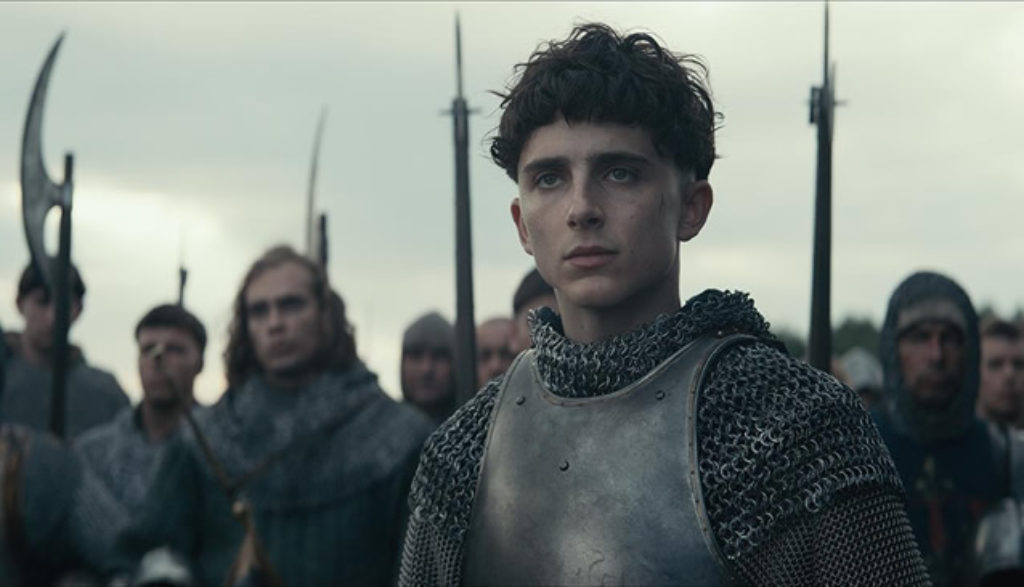
The King is loosely based on Shakespeare’s four so-called Henriad plays. And it tells the story of King Henry V of England, how he ascended to the throne and how he came to fight in the Battle of Agincourt in 1415 during the Hundred Years’ War with France.
Under his father’s rule, Henry (known affectionately as “Hal” by his close friends) and his brother, Thomas, were forced to fight in battles for causes that weren’t their own. Thomas, for his part, reveled in these conflicts. Eager to prove himself, Thomas marched willingly into battle and ultimately, to his death. Hal, in contrast, despised feeling forced into battle. Tired of his father’s mad ramblings and the constant shedding of innocent blood, he begged for peace: “I have only ever hoped for one thing, to see this kingdom united under this English crown.”
Once he becomes king, Hal attempts to end the civil unrest in England, Scotland and Wales by issuing pardons and delivering ransoms. But between the discontent brewing amongst his fellow lords and the taunting of foreign nations, he soon learns that peace and harmony aren’t so easily won. And securing that laudable goal requires strength and confidence.
Hal hates war and often ignores the advice of other noblemen regarding battles and violent displays of power. He frequently seeks the wisdom of his good friend Sir John Falstaff, who, like him, detests the wanton taking of lives and says that “nothing stains the soul more indelibly than killing.” Whenever Hal gets riled up and begins to capitulate to the more violent instincts of his comrades, Sir John grounds him and reminds Hal that he isn’t that kind of man. However, both men also recognize that certain fights cannot be avoided and willingly lay down their own lives to save countless others.
Hal’s strong, soon-to-be wife tells him that her respect must be earned. She challenges his motives for attacking France and reveals information to him about an assassination plot. At first, Hal is irritated by her uncommon boldness; but after confirming that she was telling the truth, the two agree to always be honest and clear with one another, setting a forthright tone for their future together.
Hal’s coronation takes place at Westminster Abbey and is performed by the Archbishop of Canterbury. Hal is anointed with oil, and we hear prayers on his behalf during the ceremony.
Before battle, Hal prays at an altar while holding a rosary; he crosses himself when he finishes praying. Likewise, soldiers pray silently before battle. Men shout, “For the King and St. George,” as they run into battle (the latter a reference to the patron saint of England). Hal’s father, King Henry IV, says a prayer in Latin before eating a meal, and everyone present says, “Amen.”
Members of the clergy carry staffs bearing crucifixes from battle to battle. The clergy are carried across a river by soldiers to keep their feet from getting wet. The Archbishop himself rides in a litter born by horses. Sir John’s helmet is engraved with a cross. A church with a cross on its steeple is seen in the background of a French town. The Holy Land is mentioned.
When Hal is given a mechanical, metal bird as a present, he jokingly says that he hopes its magic isn’t “black and unholy.” Someone implies that a man is possessed by a demon. A character talks about being tortured by “Welsh witches.” Hell is mentioned.
A man and woman kiss and have sex. He is shirtless, but she is fully covered by a dress-like undergarment. Hal sleeps in a bed with a woman next to him. His friend wakes the woman and helps her put a dress on over her sleeping garment before asking her to leave. A man’s feet are massaged by a young servant boy while he takes a bath. (We only see the man from the chest up.) Hal is shirtless in several scenes. A man lies shirtless on his deathbed.
Battles are fought by armored knights wielding swords. Knives are used to stab people in between the plates of their armor, through their necks and through the eye-slits of their helmets. People (and horses) are killed by flying arrows. When men lose their weapons, they resort to punching and kicking. Several people are killed when they are trampled into the mud. One man suffocates another by tackling him and holding his face in the mud.
A man is beheaded by an executioner. Three children are ambushed by enemy soldiers. One is stabbed in the back, and another is shot with a crossbow; the third is forced to carry the head of one of his friends back to their camp as a message to the king from the enemy. A man is stabbed in the back of his head.
A mortally wounded man is found by his enemy while attempting to crawl to safety. Knowing he cannot help the injured man, the enemy puts him out of his misery by stabbing him (this is done offscreen). We see an injured horse struggling on the ground during a battle. Men scavenge for weapons among the deceased after a skirmish concludes. It is mentioned that 300 men from England were killed in a battle against the Scots.
Hal cauterizes a man’s wound with a hot blade. (We see a close-up of the bloody wound and searing flesh.) A castle is besieged with flaming catapults.
The f-word is used three times. The phrase “whoring fool” is heard once. Male anatomy is mentioned. A woman is called a “hag.”
Many people drink wine at meals and in taverns (sometimes to excess). Before he succeeds to the throne, Hal has a reputation in the royal court of being a “drunken boor,” and Sir John often recounts his own nights of drunkenness to Hal. An inebriated man dances (without a shirt) in a tavern wearing the same headdress common amongst noblewomen. Alcohol is drunk by an injured man to numb his pain; it’s poured on his wound to cleanse it as well.
When Hal becomes king, he gets insight into the chaos that his father had to navigate on a regular basis. He deals with assassination plots, betrayals, petty feuds between nobles and the constant manipulations of his advisors—all while being compelled to make weighty political decisions. Despite his growing insight into his father’s character and reign, however, Hal never forgives his father.
Indeed, Hal and his father remain at odds until the king’s death. Hal believes King Henry IV is a monster and urges his younger brother not to follow in their father’s footsteps. It is also widely known that King Henry IV considers Hal to be a disappointment. When asked to visit his ailing father, Hal only consents after learning that Thomas (who would have succeeded their father to the throne) was killed in battle. And even then, he only goes to watch his father suffer in his last moments. (He pulls the blankets off his father so the king shivers from the cold as he dies.)
The Archbishop of Canterbury, despite being a man of the cloth, plays more of a political role here than a spiritual one. He is personally invested in the war with France—having given money to the cause—and he regularly tries to involve himself in tactical and political strategies by bolstering Hal’s claim to the French throne and encouraging him to take his battle campaign all the way to Jerusalem. The Archbishop also appeals to King Henry IV about taxes, suggesting that the church should not be held responsible for fixing problems it didn’t create.
A man rudely holds a handkerchief to his mouth while walking around a poorer section of England because he thinks it smells bad. The king comments on the odor there later on. A man’s body is covered in sores from an illness. Traces of vomit are seen on one character’s face. Another man is mocked for being “little more than passing keeper of a prince’s puke.”
King Henry IV refuses to pay the ransom for one of his captured cousins because he believes the cousin has betrayed him. A man is accused of being a thief and later says he never robbed anyone who didn’t deserve it. Two men cry in fear when they learn they are to be executed.
King Henry V, known throughout history as one of England’s most beloved monarchs, is a complex character. While he struggles to avoid the monstrosity of war and demonstrates mercy to his captives, he doesn’t always extend the same courtesy to his own court or even his own family. Hal does everything he can to save his brother’s life (short of dragging him off the battlefield by the cuff of the younger man’s shirt, that is), but then he cruelly watches his father suffer as the man takes his final breaths. He begs Sir John to be a trusted confidant, but then questions every choice that his friend makes.
This constant back and forth between the allure of peace and the vileness of war is confusing—both for Hal’s followers onscreen and for anyone watching this new Netflix biopic about his life at home. For a film that preaches peace so vehemently, there’s an awful lot of fighting going on here. Blood pours by the bucketful. And while profanity is less frequent in The King than most other R-rated films, it would almost certainly still shock Mr. Shakespeare, who always found a clever way around the use of foul language.
Fans of history (and/or Shakespeare) may well find the latest depiction of King Henry V quite compelling. But they’ll also be forced to confront visceral violence along the way—just as Hal himself faced in his conflict-filled journey to the English throne.


Emily studied film and writing when she was in college. And when she isn’t being way too competitive while playing board games, she enjoys food, sleep, and geeking out with her husband indulging in their “nerdoms,” which is the collective fan cultures of everything they love, such as Star Wars, Star Trek, Stargate and Lord of the Rings.